
 |
Major Features of the 1996 California Budget |
On July 8, 1996 the Legislature sent the 1996 Budget Bill to the Governor. In this report we
highlight the major features of the budget package.
I. Budget Overview II. Health and Welfare III. Proposition 98 Education IV. Higher Education V. Judiciary and Criminal Justice VI. Other Major Provisions
Appendix 1: Trailer Legislation
The Legislature passed the 1996 Budget Bill and sent it to the Governor on July 8, 1996. The Budget Bill and related implementing legislation comprise a budget package that authorizes total state spending of $61.5 billion in 1996-97, an increase of 2.4 percent from 1995-96. Of this total, $47.3 billion is from the General Fund and $14.2 billion is from special funds.
The General Fund picture improved over the past year as a result of ongoing economic recovery and unexpectedly strong growth in state tax receipts. The revenue increases enabled the Legislature to provide major increases in funding for K-12 education, close to full funding for corrections, increases for each of the higher education segments, and a corporation tax cut beginning in January 1997.
As shown in Figure 1, revenues are projected to grow by 3.3 percent, while expenditures grow by 4.0 percent. The General Fund is projected to end 1996-97 with a reserve of about $300 million.
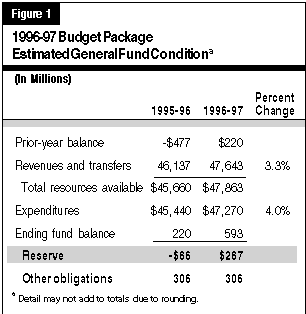
Taxes. The budget package provides for a five percent reduction in the corporation tax rate, from 9.3 percent to 8.84 percent, effective for income years beginning January 1, 1997. This tax cut is in lieu of the Governor's proposal for a phased 15 percent reduction in both personal and corporation income taxes. The revised tax cut will reduce revenues by $85 million in 1996-97.
K-12 Education. Growth in revenues and the Proposition 98 spending guarantee enabled the Legislature to provide major increases in K-12 per pupil funding in both 1995-96 and 1996-97. The budget includes new funds for class size reduction in grades K-3 ($771 million in 1996-97), and one-time funds for block grants ($587 million) and portable facilities to accommodate class size reductions ($200 million).
Higher Education. The budget includes significant funding increases for the University of California, California State University, and Community Colleges, with no student fee increases.
Health and Welfare. The budget extends or makes permanent past grant reductions in the state's AFDC and SSI/SSP programs, but does not adopt any new cuts. Specifically, it makes the 1992-93 welfare grant reductions permanent and extends the statewide 1995-96 grant reduction through October 1997. With regard to cost-of-living adjustments (COLAS), the budget suspends state COLAs for AFDC and SSI/SSP through October 1997, but provides the full federal SSI COLA to recipients.
As regards the state's health programs, the budget (1) assumes the elimination of funding for long-term care and prenatal services for illegal immigrants beginning January 1, 1997 (implementing legislation has not yet passed), (2) expands teen pregnancy prevention programs, and (3) extends the Medi-Cal Supplemental Drug Rebate Program until January 1, 1997, after which rebates could be negotiated with individual manufacturers.
Corrections. The budget includes close to full funding for corrections. It contains no policy changes and no funding for new prisons. The budget includes some reductions for caseload adjustments and administrative costs.
Local Government. The budget includes two key provisions affecting local finances. It provides $100 million for local law enforcement and $50 million to the Board of Corrections for juvenile justice grants. The budget also adopts the Governor's proposed changes to trial court funding. Under the plan, the state will assume responsibility for future growth in trial court costs.
Renters' Credit. The budget extends the suspension of the renters' tax credit for 1996. The Governor had proposed permanent elimination of the credit.
Figure 2 shows that the budget relies on federal actions to achieve $762 million in savings, mostly in health and welfare programs. Of this total, about $430 million is related to the elimination of federal maintenance-of-effort requirements, which would allow California to implement previously enacted reductions to AFDC and SSI/SSP grant levels. The budget assumes that federal actions would be taken by August 1996 which would permit a reduction in AFDC grants effective in October 1996, and a reduction in SSI/SSP grants effective in November 1996.
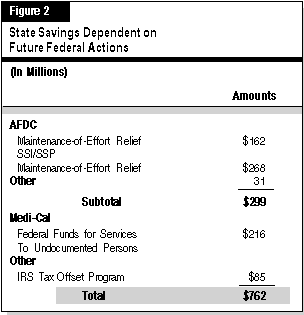
The remainder of the federal actions are primarily related to (1) new federal reimbursements for
state costs of providing emergency Medi-Cal services to illegal immigrants ($216 million), and
(2) the federal adoption of an IRS tax offset program ($85 million), under which the federal
government would collect delinquent state taxes out of the refunds owed to federal taxpayers.
Prepared by the Economics and Forecasting Section--(916) 324-4942
General Fund support for health and welfare programs in 1996-97 totals $ 14.4 billion, an increase of less than 1 percent over the prior year.
Figure 1 describes the major General Fund changes enacted in the 1996 Budget Act and related legislation.
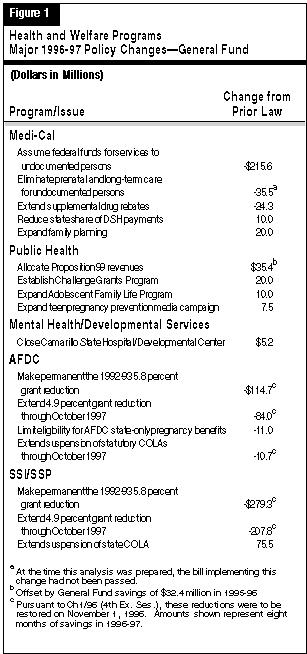
Federal Funds for Services to Undocumented Persons. The budget assumes receipt of $216 million in federal funds to partially offset state costs for emergency health services provided to illegal immigrants.
Prenatal and Long-Term Care for Undocumented Persons. The budget assumes adoption of the Governor's proposal to eliminate prenatal benefits and long-term care (new applicants) for illegal immigrants, beginning January 1, 1997, for a General Fund savings of $34.7 million and $856,000, respectively. At the time this analysis was prepared, however, implementing legislation had not been passed by the Legislature.
Supplemental Drug Rebates. Budget-related legislation extends the Supplemental (Ten Percent) Drug Rebate program through December 31, 1996, for a General Fund savings of $17.3 million. The legislation also extends, for two years, the authority for the department to negotiate drug rebates with individual pharmaceutical manufacturers. The budget assumes savings of $7 million in 1996-97 due to the extension of this program.
Disproportionate Share Hospital (DSH) Payments. The budget includes a $10 million General Fund augmentation in order to backfill for a reduction in the state's share of federal disproportionate share hospital payments, thereby providing the federal funds to hospitals (primarily county hospitals) that care for a relatively large number of low-income persons.
Family Planning Program. The budget includes a $20 million General Fund augmentation to support the Governor's proposal to expand family planning services. Beginning January 1, 1997, the existing non-Medi-Cal family planning program will be consolidated with the Medi-Cal program to create a new entitlement program for persons with family incomes at or below 200 percent of the federal poverty level. The new program sunsets July 1, 2000, and if not extended, the previous program will be reinstated.
Proposition 99. The Legislature adopted the Governor's proposal for 1995-96, thereby allocating revenues to the various accounts in accordance with the percentages specified in Proposition 99. As regards the budget year, however, the Legislature rejected the Governor's proposal to change the allocation of Proposition 99 revenues, which would have required a 4/5 vote of the Legislature. Instead, the Legislature allocated the revenues consistent with the provisions of Proposition 99. In addition, the plan for 1996-97 calls for significant increases in spending for (1) health education programs administered through the Departments of Education and Health Services, including $5 million earmarked for smoking cessation classes, and (2) smoking- and tobacco-related research by the University of California. The plan is estimated to result in General Fund savings of $32.4 million in 1995-96 and costs of $35.4 million in the budget year.
Teen Pregnancy Prevention and Teen Parenting. The Legislature adopted, in part, the Governor's proposal to expand teen pregnancy prevention programs by appropriating $7.5 million to expand the media campaign and
$20 million to establish a new Challenge Grants program to fund local teen pregnancy prevention projects. The budget also appropriates $10 million to expand the Adolescent Family Life Program, which provides case management and other support services for pregnant and parenting teens.
Camarillo State Hospital and Developmental Center. The budget includes $5.2 million from the General Fund (including the state share of reimbursements from the Department of Health Services) to begin implementation of the closure of the Camarillo facility.
Grant Reductions. Budget legislation extends the 1995-96 4.9 percent statewide grant reduction through October 1997 and makes permanent the 1992-93 5.8 per-cent grant reduction. This results in combined General Fund cost avoidance and savings of $199 million in 1996-97. Implementation of the 4.9 percent grant reduction is contingent upon federal approval. The maximum monthly grant for a family of three will be reduced from $594 to $565 in high-cost counties and to $538 in low-cost counties.
Cost-of-Living Adjustment (COLA). The budget extends the suspension of the COLAs for AFDC grants, and AFDC Foster Care group home rates, through October 1997. This results in General Fund savings of $10.1 million in AFDC grants and $0.6 million in Foster Care rates.
Pregnancy Benefits. Budget legislation limits eligibility for state-only AFDC pregnancy benefits to recipients who are eligible for the Cal Learn Program (teen parents who have not graduated from high school). This results in General Fund savings of $11 million in 1996-97.
Grant Reductions. The budget extends the 1995-96 4.9 percent statewide grant reduction through October 1997 and makes permanent the 1992-93 5.8 percent grant reduction. This results in combined General Fund cost avoidance and savings of $487 million in 1996-97. Implementation of the 4.9 percent grant reduction is contingent upon federal approval. The maximum monthly grant for aged and disabled individuals (the largest category of recipients) will be reduced, in November 1996, from $626 to $596 in high-cost counties and to $568 in low-cost counties. Recipients will receive a federal COLA in January 1997, amounting to $16 for individuals.
State COLA. Budget legislation extends the suspension of the state COLA for one year. Prior law
would have resumed the state COLA, which--because of the interaction with the federal
COLA--would have resulted in a state savings. Thus, by not providing the state COLA, the
budget legislation results in a General Fund cost of $75.5 million, compared to prior law. As
noted above, however, recipients will receive the full federal SSI COLA on their grants
Prepared by the Health and Social Services Section--(916) 445-6061
In this section, we describe the major features of the budget package as it relates to the Proposition 98 minimum funding guarantee and K-12 schools.
The K-12 portion of the Proposition 98 budget package includes:
Figure 1 summarizes for 1995-96 and 1996-97 the effect of the budget package on K-12 schools, community colleges, and other specified agencies. The budget proposes $29.1 billion for Proposition 98 in 1996-97. This represents an increase of $1.7 billion, or 6 percent, from the revised 1995-96 funding level. Almost all of this increase is from the state General Fund because local property taxes are projected to increase only slightly in 1996-97.
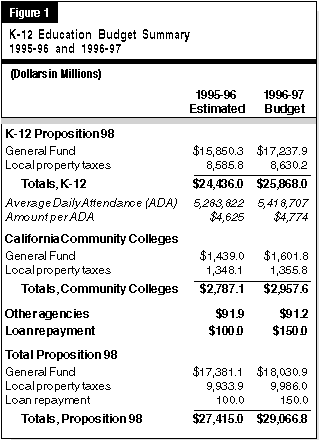
Proposition 98 funding for K-12 schools totals $25.9 billion. This represents an increase of $2.5 billion, or 11 percent, from the funding level included in the 1995 Budget Act. This large increase results from two sources. First, the 1995-96 minimum funding guarantee increased from the budgeted level by $1.1 billion due to higher-than-anticipated General Fund revenues. The budget spends these 1995-96 settle-up funds on one-time activities. As a result, these funds also are available in 1996-97 for ongoing activities. Second, the budget assumes the 1996-97 K-12 share of Proposition 98 funds will increase by $1.4 billion, or 5.9 percent. As a result, a total of $2.5 billion in new funds is included in the 1996 budget for K-12 education.
As Figure 1 also shows, community college funding in 1996-97 increases by $170 million from the revised 1995-96 level. We discuss the community colleges' budget in the higher education section of this report.
1996-97 Baseline Increases. As discussed above, compared to the 1995 Budget Act, K-12 Proposition 98 funding increased by $2.5 billion in 1996-97. Of this amount, the budget allocates $1.2 billion to provide inflation and growth adjustments. Specifically, the budget includes about $400 million to accommodate a projected 2.6 percent increase in the student population and $800 million for a cost-of-living adjustment (3.2 percent) for K-12 programs.
The budget directs the remaining $1.3 billion for other purposes, including new programs and existing K-12 categorical programs. Figure 2 displays the major K-12 Proposition 98 appropriations for 1996-97.
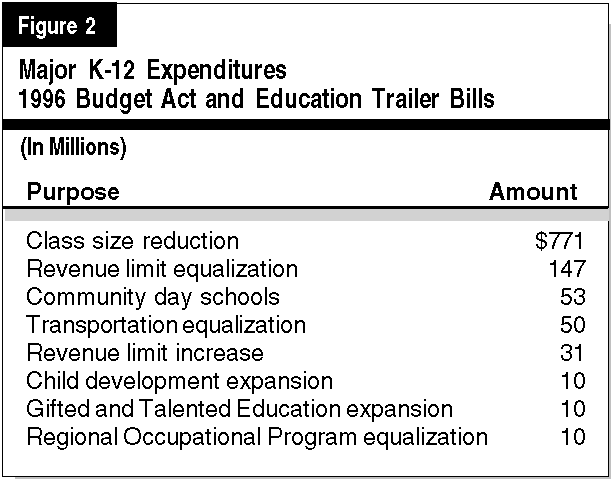
Class Size Reduction. The budget dedicates a major portion of the remaining funds to provide $771 million to reduce class sizes in Kindergarten through grade three. The features of this new program are as follows:
Other 1996-97 Initiatives. As Figure 2 illustrates, the budget contains a number of other program increases. The budget includes an additional $178 million for revenue limit increases ($147 million to equalize school district revenue limits and $31 million for general revenue limit increases). Assembly Bill 3497 (Richter) contains the statutory changes needed to implement the equalization provisions. The bill also contains a provision that directs the use of any additional Proposition 98 funds that may become available during the year. It provides that additional funds shall be used to provide further increases in revenue limit equalization (50 percent) and across-the-board increases in district revenue limits (50 percent).
1995-96 and Prior Years Settle-Up Funding. Proposition 98 minimum funding levels are determined by one of four specified formulas, each using a set of specified factors. Because the factors change during the year, the minimum funding guarantee under Proposition 98 also changes. Any additional amount needed to satisfy the guarantee is referred to as Proposition 98 "settle-up" funding.
The budget contains approximately $1.3 billion in settle-up funding for K-12 programs. Figure 3 displays the major allocations of these monies. The Legislature appropriated most of these funds for one-time activities. More than half of the one-time funds were distributed in the form of local block grants. Specifically, the budget allocates a total of $387 million in block grants to local school sites for one-time expenditures. Each school will receive about $70 per student, with no school receiving less than $25,000. In addition, the budget provides $200 million in block grants to school districts. Under this grant, each district will receive about $37 per student.
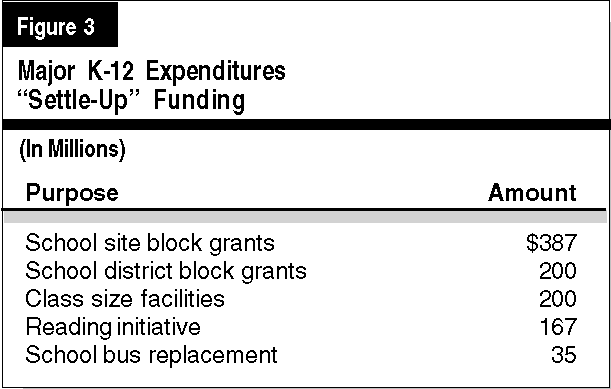
As Figure 3 illustrates, the budget also includes $200 million to provide support for "portable" classrooms that districts will need in order to reduce class sizes in the primary grades. The budget specifies that schools will receive $25,000 per portable. Therefore, this funding is sufficient to purchase about 8,000 new classrooms. The budget also appropriates $167 million for a reading initiative. Of this amount $152 million is for new instructional materials, $13 million for staff development, and $2 million for district leadership training.
Prepared by the Education Section--(916) 445-8641
Figure 1 shows the change in funding for each major segment of higher education for 1996-97 from selected fund sources.
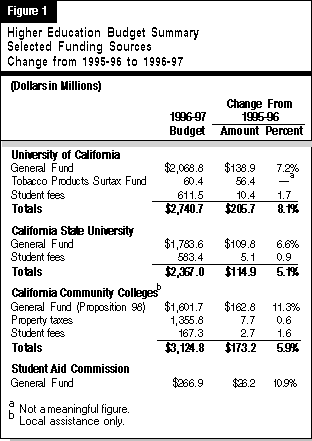
The 1996 Budget Act, as passed by the Legislature, provides $139 million (7.2 percent) more in General Fund support for the University of California (UC) in 1996-97 compared to 1995-96. The budget assumes no general increase in undergraduate and graduate student fees, although the third year of a four-year planned increase in graduate professional program fees (including law, medicine, dentistry, and veterinary medicine) will generate an expected $10.4 million in revenues for the UC in 1996-97.
The Legislature approved a budget plan for the UC that includes:
The 1996 Budget Bill, as passed by the Legislature, provides $110 million (6.6 percent) more in General Fund support for the California State University (CSU) in 1996-97 than in 1995-96. As with the UC, the budget assumes no general increase in student fees.
The Legislature approved a budget plan for the CSU that includes:
Because of the major increases in Proposition 98 funding in 1995-96 and 1996-97, the 1996 budget package contains major funding increases for community colleges (see the Proposition 98 section for more details). Specifically, General Fund spending for community colleges totals $1.6 billion in the budget year. This represents a $308 million, or 24 percent, increase above the funding level included in the 1995 Budget Act. Because the
1995-96 community college share of Proposition 98 funds also increased (by $145 million due to higher-than-anticipated General Fund revenues), the projected year-to-year increase in General Fund spending for community colleges shown in Figure 1 is $163 million, or 11 percent. The budget does not contain any increase in student fee levels. (Fee revenues, however, will increase slightly due to enrollment growth.)
1996-97 Expenditures. Figure 2 illustrates the major program increases provided with the additional funds in 1996-97. The budget includes $54 million to fund additional enrollment growth at new centers ($20 million) and new facilities at existing campuses ($24 million). These centers and facilities had been built during the early 1990s but never received additional funding for growth in student attendance. The total of $54 million also includes additional maintenance funding for these centers and facilities ($10 million). The budget also provides $40 million to equalize district per-student funding levels ($14 million) and program improvement ($26 million).
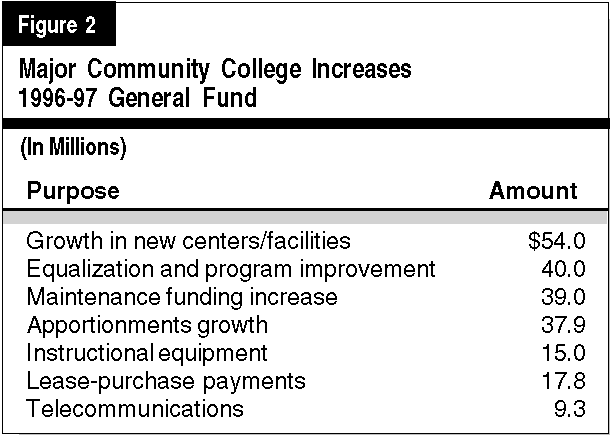
Settle-Up Expenditures. The budget includes $166 million in settle-up funding for four one-time activities. Of this amount, the budget allocates $75 million for district block grants, which will be allocated on a per-student basis. The budget also provides $60 million to increase support for deferred maintenance and
$20 million for removing architectural barriers to disabled persons. Finally, the budget contains $9.4 million to provide funding that was lost in 1995-96 when property tax revenues to community colleges were lower than expected.
The budget appropriates $267 million for the Student Aid Commission in 1996-97, which is an increase of
$26 million, or 11 percent. Of this amount, $20 million represents an increase in the Cal-Grants program, which provides financial aid to higher education students in California. The augmentation provides a $10 million increase in the number of new financial aid awards in all Cal Grant aid categories and $10 million to increase the maximum grant amount for students attending private colleges and universities.
Prepared by the Education Section--(916) 445-8641
The 1996-97 budget for judiciary and criminal justice programs totals $5.1 billion, including $4.5 billion from the General Fund and $655 million from state special funds. This is an increase of $260 million, or about 5.3 percent, over 1995-96 expenditures. This increase is primarily due to increases in spending to accommodate the projected growth in the state's prison inmate and parole populations.
The amount is about $186 million below the Governor's January Budget. The principal reason for the change is revised downward estimates of the prison inmate population contained in the May Revision.
The major changes in the 1996 Budget Act relative to the Governor's Budget are discussed below
and summarized in Figure 1.
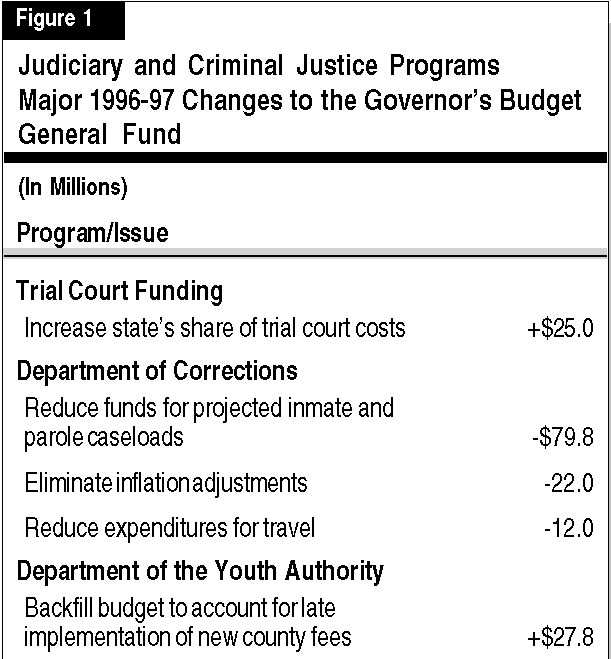
The 1996 Budget Act includes $1.6 billion for support of the trial courts in 1996-97 and assumes enactment of the Governor's proposal to consolidate and restructure the Trial Court Funding Program. The changes to accomplish the Governor's proposal are included in
AB 553 (Isenberg), which is still under consideration.
Under the Governor's plan, counties annually will transmit $890 million to the state Trial Court Trust Fund for support of the courts. This county share would be capped and would not change in future years. The plan also calls for redirection from the General Fund to the Trial Court Trust Fund of about $298 million in revenues, which would be used to support the trial courts. In addition, the plan proposes to increase court-related fees to generate $91 million in additional revenues to the fund, bringing total fees to $246 million in 1996-97.
The Governor's January Budget requested $160 million from the General Fund to support the program, which was subsequently increased to $185 million in the May Revision. The Budget Act also assumes that the existing formula under which fine revenues are transmitted from cities and counties to the state will be changed so that cities retain $7.5 million in revenues.
In addition, the budget includes $2 million to support 20 new trial court judgeships beginning in the last quarter of 1996-97. The new judgeships will have to be established in separate legislation.
The budget provides a total of $3.5 billion ($3.5 billion from the General Fund and $52 million from special and bond funds) for support of the California Department of Corrections (CDC). This represents an increase of about 8 percent above the 1995-96 level and is primarily due to projected increases in inmate and parole populations. The budget reflects a reduction of about $57.8 million below the January request as a result of caseload changes contained in the May Revision. The most significant changes made by the Legislature were an additional reduction in funds requested for inmate population increases to reflect more recent trends ($22 million), elimination of funds for inflation adjustments ($22 million), and reduction in funds requested for travel ($12 million).
The 1996 Budget Act includes no funds for planning or construction of new prison facilities.
Inmate Caseloads. The Legislature considered a number of changes that would have saved money by reducing the number or length of stay of offenders in prison and on parole. None of these changes were included in the final budget, however. The budget assumes that the prison inmate population will reach about 156,000 inmates by June 30, 1997, an increase of approximately 9.5 percent over 1995-96.
Federal Funds for Incarceration and Supervision of Undocumented Felons. The budget assumes a total of about $514 million in federal funds to offset the state's costs of supervising undocumented inmates and wards in state prison and the Department of the Youth Authority in 1995-96 and 1996-97. This amount is about $87 million less than the amount assumed in the Governor's January Budget for the two-year period and is consistent with estimates of California's share of existing federal appropriations and authorizations.
The budget provides $402 million ($394 million from the General Fund and $8.2 million from special and bond funds) for support of the Youth Authority.
Delay in Implementation of New County Fees. The amount included in the Budget Act for the Youth Authority is about $24 million more than the level requested in the January Governor's Budget. The principal reason for this increase is that the January budget assumed that legislation would be enacted and take effect on
February 1, 1996, to increase the fees that counties pay the state for commitment of juvenile offenders to the Youth Authority; however, the new fees will not take effect until January 1, 1997. Thus, the Legislature augmented the budget for the Youth Authority to account for the state receiving less fee revenues than originally anticipated from counties.
"M Case" Transfer. In addition, the budget anticipates transferring from the Youth Authority to the CDC custody of "M cases" who are 18 years of age or older. ("M cases" are offenders who are sentenced to the CDC, but who are transferred to the Youth Authority to serve all or part of their incarceration time.) Because the costs of housing offenders in the CDC is less than the costs of the Youth Authority, the budget anticipates net savings of $2.1 million in 1996-97.
The budget includes $150 million for two new major local law enforcement programs.
Assistance for Direct Law Enforcement. In his January budget, the Governor proposed $150 million of state funds for local law enforcement under the Citizens' Option for Public Safety (COPS) program. Specifically, the Governor proposed to modify the state's personal income tax forms to allow taxpayers to decide whether a percent of their income tax liability should be subvened to local agencies to augment police, sheriff, and prosecution programs. (The administration estimated that this "check-off" program would generate $150 million annually to local agencies.)
The Legislature rejected the COPS program, but approved $100 million from the General Fund for subvention to local governments for law enforcement. Of this amount, $75 million would be distributed to cities and counties for police and sheriffs' patrol services. The remaining $25 million would be distributed to counties for district attorneys ($12.5 million) and jail services provided by sheriffs ($12.5 million). The funds would be distributed based on the population of the jurisdiction.
Juvenile Justice Grant Program. The budget also includes $50 million for a new Juvenile Crime Enforcement and Accountability Challenge Grant Program. This money, which is appropriated to the Board of Corrections, would be awarded on a competitive basis to counties that develop and implement a comprehensive plan to provide a continuum of responses to juvenile crime and delinquency, including prevention, intervention, suppression, and incapacitation programs.
Prepared by the Criminal Justice Section--(916) 445-4660
The Legislature did not approve any general purpose local fiscal relief program this year. The major new program affecting local government was the addition of $150 million for local law enforcement and prevention of juvenile crime (see Judiciary and Criminal Justice).
The Renters' Tax Credit provides a refundable tax credit of $60 to single renters and $120 to married couples and heads of households. The credit was suspended in 1993, 1994, and 1995. The credit was scheduled to be reinstated this year but was suspended for an additional year, saving $520 million.
The budget includes a $14 million General Fund loan to the Insurance Fund to pay for a $14 million overexpenditure in the department's 1995-96 budget arising from a court judgment and revenue shortfall. The Legislature approved a trailer bill (AB 3137, Miller) to escheat $14 million in unpaid Proposition 103 rebates to the Insurance Fund (rather than the General Fund) after July 1, 1997 to repay the General Fund loan.
The 1996 budget provides a total of about $1 billion for resources programs, including about $860 million for state operations of various resources agencies and conservancies, and $181 million for local assistance and capital outlay. Significant features of the budget include:
For environmental protection programs, the budget provides about $661 million in 1996-97, including about $597 million for state operations of various environmental protection agencies and $64 million for local assistance. Significant features include:
The 1996 budget provides about $1.6 billion for support of the Department of Transportation (Caltrans)--roughly the same amount as in 1995-96. Not included in this amount is $193 million for departmental support costs related to seismic retrofit of highway bridges and toll bridges from the Seismic Retrofit Bond Act of 1996 (Proposition 192).
The budget also provides $1.6 billion for transportation capital outlay projects. In addition, the budget anticipates that Caltrans will use $1.1 billion of Proposition 192 funds for seismic retrofit capital outlay in 1996-97. This amount includes $540 million to substantially complete highway seismic retrofit, and $541 million, out of an estimated total need of $1.7 billion, for toll bridge seismic retrofit.
The budget provides $879 million for a variety of local assistance programs, primarily a pass-through of federal funds for highway and transit purposes and state funds for the State-Local Transportation Partnership Program. This amount is 4 percent less than in 1995-96. Assistance to transit authorities includes $76 million for operating assistance (through the State Transit Assistance program) and $25 million for capital acquisition (through the Transit Capital Improvement program). In addition, the budget provides $8.3 million to fund local transportation demand management (primarily carpool matching) programs in 1996-97.
The budget includes $760 million (about 80 percent from general obligation bonds) for capital outlay, as shown in Figure 1. Of the $615 million in total bond funding, $63 million (for the Departments of Corrections and the Youth Authority) is dependent on legislative and voter approval of a proposed bond measure for the November 1996 election. No funds were provided for new prisons.
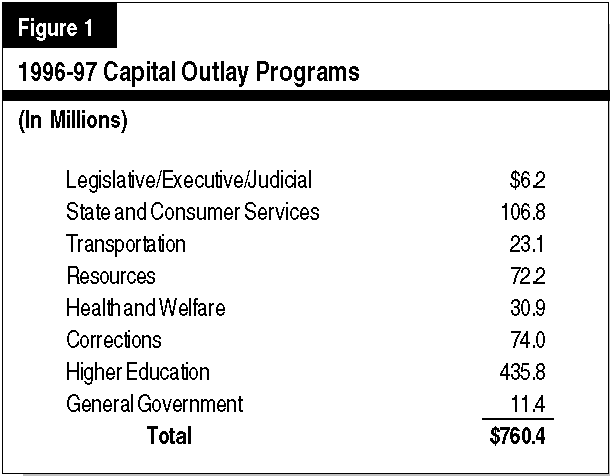
The remaining capital outlay funding is from the General Fund ($71 million), various special funds ($64 million), and federal funds ($9 million). Almost 60 percent of the total capital outlay funding is for the three segments of higher education and comes principally from bonds that were approved by the voters in March.
Prepared by the following sections:
Business, Labor, and Capital Outlay--(916) 332-8402
Transportation and Resources--(916) 445-5921
State and Local Finance--(916) 445-6442
Bill |
Author |
Subject |
| AB 2972 | Olberg | Education: Home-to-school transportation equalization |
| AB 3137 | Miller | Insurance: Escheated Proposition103 rebates |
| AB 3229 | Brulte, Lockyer | Local Government/Public Safety: Grants to local governments |
| AB 3369 | Bordonaro, Wright | Corrections: "M" Cases |
| AB 3482 | Davis | Education: Reading Initiative |
| AB 3483 | Friedman | Health Services: Various (public health, drug rebates, etc.) |
| AB 3484 | Friedman, Granlund | Health Services: Technical changes to AB 3483 |
| AB 3487 | Katz, Pringle | Health Services: Proposition 99 |
| AB 3488 | Ducheny, Petris,Cunneen | Education: Various ("Settle-up" appropriations, deficit reduction) |
| AB 3492 | Frusetta | Education: School safety and training programs |
| AB 3493 | Committee on Budget | General Government: Various (disaster relief, Museum of Science and Industry, budget information) |
| AB 3495 | Kaloogian, Kopp | Resources: Various (cooperative fire fighting agreements, Fire Marshall, OHV fees) |
| AB 3497 | Richter | Education: Revenue limit equalization |
| AB 3499 | Pringle, Lockyer, Hurtt | Bank & Corporation Tax: 5percent rate reduction |
| SB 1472 | Solis | Social Services: County match relief |
| SB 1556 | Johnston, Leslie | Social Services: Identification of persons in jail ineligible for aid |
| SB 1760 | Lockyer, Goldsmith | Corrections: Juvenile justice |
| SB 1763 | Committee on Budget | General Government: Performance budget contracts (Departments and Fiscal Review of Consumer Affairs and General Services) |
| SB 1770 | Johnston | General Government: Surplus state property and Capitol Area Plan development |
| SB 1771 | Kopp | General Government: Hawkins Data Center |
| SB 1777 | O'Connell, Peace, Wright, Baldwin,Alpert, Firestone, Machado | Education: Class-size reduction |
| SB 1780 | Committee on Budget | Social Services: Various (grant reductions, etc.) and Fiscal Review |
| SB 1789 | Greene | Education: Facilities for class-size reduction |
| SB 1794 | Wright | Renter's Tax Credit: Suspension in 1996 |
Return to LAO Home Page